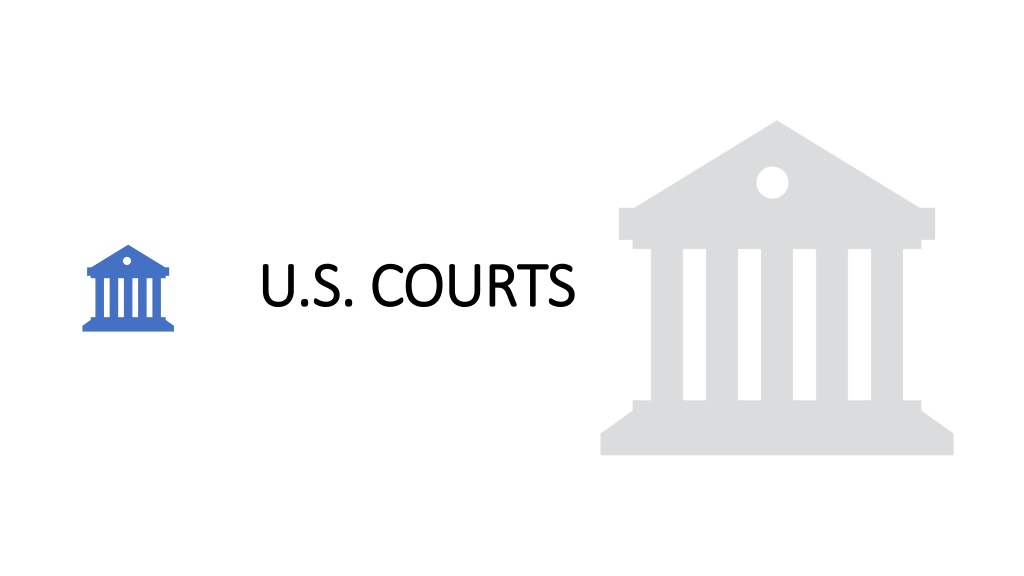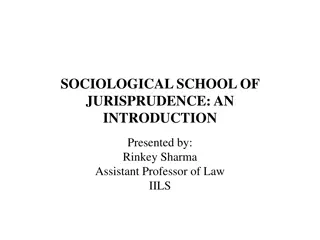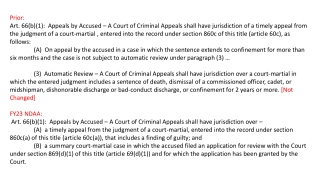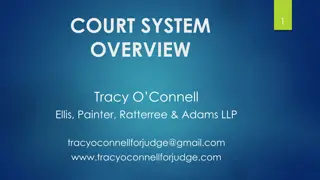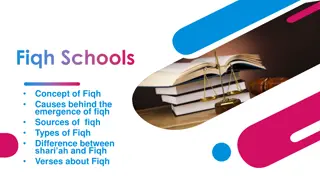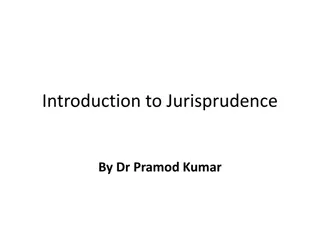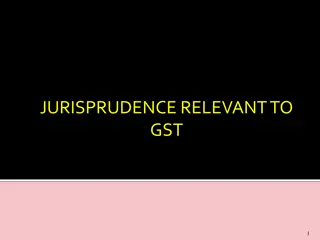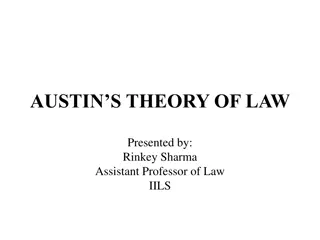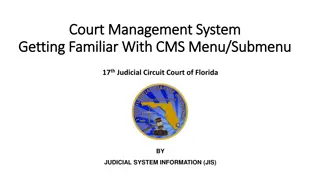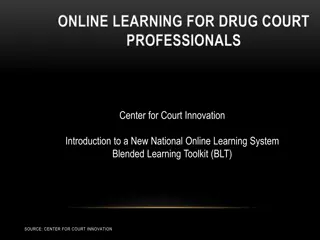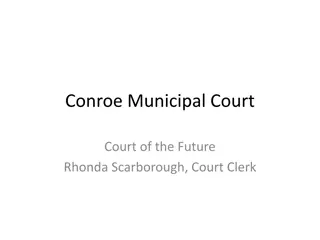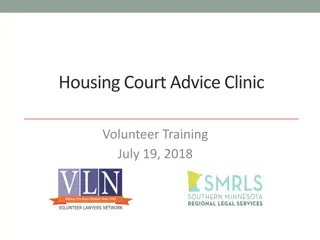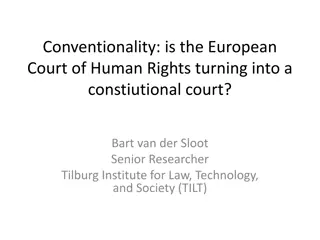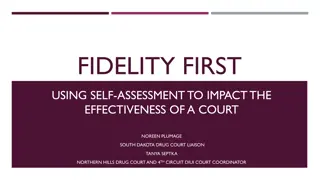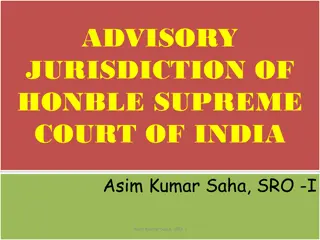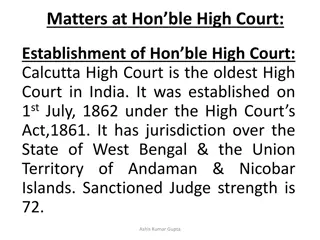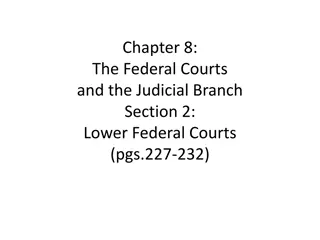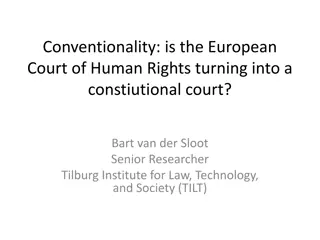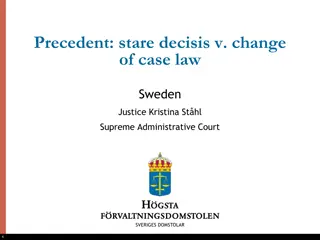Understanding the U.S. Court System: Jurisprudence and Structure
Law enforcement officers play a crucial role in the criminal justice system by understanding criminal jurisprudence and the court system's structure. This includes knowledge of different court levels, jurisdiction, and the adjudication process. The duality of courts, such as adult vs. juvenile courts, felony vs. misdemeanor courts, and federal vs. state courts, adds complexity to the legal landscape. Each state has its court system, comprising limited and general jurisdiction trial courts, intermediate courts of appeals, and appellate courts of last resort. Guam's court history showcases the evolution of its court system since 1950.
Download Presentation

Please find below an Image/Link to download the presentation.
The content on the website is provided AS IS for your information and personal use only. It may not be sold, licensed, or shared on other websites without obtaining consent from the author. Download presentation by click this link. If you encounter any issues during the download, it is possible that the publisher has removed the file from their server.
E N D
Presentation Transcript
U.S. COURTS U.S. COURTS
Law enforcement officers must be familiar of criminal jurisprudence. Jurisprudence the science or philosophy of law in a given area, or a department of law. Gatekeepers of the criminal justice system. If called to testify must be familiar with the courtroom as well as different courts (federal or state/local) or levels of courts. Must be familiar with supervision/release status after conviction/sentencing/imprisonment.
The Court System: An Overview The Court System: An Overview Dualities exist in courts structure. Jurisdiction is one duality. Jurisdiction geographic area court s authority to try/adjudicate, a case or to hear an appeal. Original vs. Appellate Jurisdiction Court with original jurisdiction authority to try and decide cases Court with appellate jurisdiction authority to hear an appeal to the decision of the original court. Diagram 13.1 page 514
Other duality adult and juvenile court, felony and misdemeanor court, federal and state court, etc. Adjudication process of judicially deciding a legal case. Trial Court court with authority to adjudicate cases. Court of Record trial court since first to record proceedings. Court of Last Resort highest court to which a case can be appealed.
The State Court System The State Court System Each state s constitution and statutory law establish its court structure. See Figure 13.1 page 514 Limited Jurisdiction Trial Courts General Jurisdiction Trial Courts Intermediate Courts of Appeals (39 states) Appellate Courts of Last Resort (Supreme Court)
Guam Court History Guam Court History Established in 1950 Organic Act of Guam District Court of Guam established jurisdiction over local and federal cases 1950 Guam Legislature established Island Court of Guam jurisdiction over misdemeanors and civil cases with value less than $2,000 Police Court jurisdiction over certain misdemeanor crimes petty offense courts presided by Commissioners of each municipality - maximum punishment no more than $5.00 fine
Superior Court established in 1974 all cases from Island Court and Police Court subsumed by Superior Court 1984 Omnibus Territories Act Congress established Supreme Court of Guam Specialty Courts problem-solving courts - - 1987 Family Court - 2002 Juvenile Drug Court - 2004 Adult Drug Court - 2009 Mental Health Court - 2011 DWI Court - 2015 - Veterans Court - Reentry Court
District Court of Guam all federal cases Civil, criminal, bankruptcy, admiralty, etc. Grant U.S. citizenship (naturalization ceremony) Local tax cases Organic Act of Guam Specialty Court problem solving court - - 2009 - Drug Offender Reentry Program (DORE)
Juvenile Courts Juvenile Courts Established in 1899 - Cook County, Illinois, first juvenile court Juvenile Court Act purpose - help rehabilitate wayward children so that they could become productive community members. Also, gave juvenile court authority to handle youths who broke the law, and to regulate treatment and control of despondent, neglected and delinquent children. One-pot approach viewed poor and abused children as equal to delinquent and criminal children and treated them the same way.
Parens Parens Patriae Patriae the right of the government/state to take care of minors and others who cannot legally take care of themselves. Petition document alleging a juvenile is delinquent, status offender or dependent and asks the court to assume jurisdiction of the child. Adjudication Hearing similar to a preliminary hearing or trial. Attorneys are appointed and evidence is presented in support of the petition. Preponderance of the evidence.
Disposition Hearing judges disposition of the case make the child a ward of the court - place child in foster care, institution, probation or return to parents. Emancipated minor a minor (not yet of legal age, 18) who has been legally freed by the court from control of his/her parents or guardian.
The Federal Courts The Federal Courts Has 4 tiers magistrate courts (Non-Article III courts), district courts, appellate courts, and the U.S. Supreme Courts. District courts in the 50 states, appellate courts and the U.S. Supreme Court Article III courts (U.S. Constitution) Lifetime appointment, removal through impeachment or voluntary retirement District courts in territories Article IV courts - 10 year term
94 districts - 94 district courts Guam 93rd, Northern Mariana Islands 94th 12 Circuits (11 plus Washington D.C.) 12 Appellate Courts (Courts of Appeals) Ninth Circuit Guam, NMI, Hawaii, California, Alaska, Washington, Arizona, Idaho, Nevada, Oregon, and Montana Courts of Appeals for Federal Circuit Courts of Appeals for the Armed Forces Courts of Appeals is usually the final stop for most defendants.
The Supreme Court The Supreme Court High Court of Last Resort 9 justices appointed by the President, and confirmed by the U.S. Senate. Chief Justice (appointed by the President) Justice John Roberts Associate Justices Clarence Thomas, Ruth Bader Ginsburg, Steven Breyer, Samuel Alito, Sonia Sotomayor, Elena Kagen, Neil Gorsuch and Brett Kavanaugh Not all cases heard by Supreme Court.
Writ of certiorari request for a transcript of the court proceedings for review. The Supreme Court s ruling on a case becomes precedent, referred to as a landmark decision, which must be honored by all lower courts. These landmark decisions/precedents influence and mold the operation of government, to include law enforcement procedures, as well as social issues in everyday life.
Specialized Courts Specialized Courts - - address specific criminal justice cases. Tribal Courts Tribal Courts - - Native American law Native American jurisdiction/government trial, appellate, and specialized civil, criminal, family, healing and wellness, juvenile and drug courts. Federal courts have jurisdiction in Indian country for certain serious offenses, mostly felonies, committed by Natives on Native land.
Community Courts Community Courts neighborhood-based and seek to solve local problems. Bring together local resources to create problem-solving partnerships with government agencies, community groups, and social service providers. Focus on quality of life crimes and cleaning up neighborhoods from crime and neglect. 36+ community courts in U.S.
Problem Problem- -Solving Courts Solving Courts active use of judicial authority to solve problems, i.e. achieve outcomes for victims, offenders and society. Use collaborative approach rely on both government and nonprofit partners. Drug Courts, DWI Courts, Domestic Violence Courts, Mental Health Courts, Homeless Courts, Reentry Courts, Teen Courts/Youth Courts, Juvenile Drug Courts and Gun Courts, Waiver to Adult Courts
Common elements of problem-solving courts: - Focus on outcomes - System Change reform on how government responds to problems, i.e. drug addiction, mental illness, etc. - Judicial Involvement judges have more hands-on approach - Collaboration work with partners - Non-Traditional Roles not common as traditional courts - Screening and Assessment use screening and assessment tools to identify participants - Early Identification of Potential Candidates identify participants early stage of criminal justice process Outcomes are evaluated through active and ongoing collection of data.
The Adversary System The Adversary System the accuser vs. the accused The accuser (prosecutor) must prove that the accused (person arrested) is guilty of a crime. Presumption of innocence the accused is presumed to be innocent until proof is clearly established. Prosecutor Victim Law enforcement officer Defense Attorney Defendant (accused) vs.
Reasonable doubt after comparing and considering all the evidence, the state of a case in which the jurors cannot say they feel a conviction/certainty of the truth of the charge; moral uncertainty of the truth of the charges. Must be beyond reasonable doubt beyond reasonable doubt - judge or jury criminal case Civil case preponderance of the evidence more likely than not, based on the bulk of the evidence Refer to page 524, Table 13.1
Key Players in the Judicial Process Key Players in the Judicial Process defendant, prosecutor, defense attorney, judge and jury The Defendant The Defendant person accused of committing the specified crime The Bill of Rights sets forth defendant s rights - 5thAmendment guarantees due process notice of hearing, full information regarding charges, opportunity to present evidence before an impartial judge or jury, and right to refrain from self-incrimination - 6thAmendment requirements for criminal trials, speedy public trial by an impartial jury, and right to a lawyer - 8thAmendment forbids excessive bail
The Prosecutor (Government) The Prosecutor (Government) represents the government/people in the criminal justice system Attorney General s Office, U.S. Attorney s Office, District Attorney s Office Selects cases to be prosecuted, charges to be brought before the court, recommends bail amount for pretrial release, approves any plea bargains and recommends sentences. Prosecutor works with the law enforcement officer Also act as legal advisors to law enforcement And protects the rights of all involved, including the suspect
The Defense Attorney The Defense Attorney represents the accused (defendant) in court. Public Defender a court appointed attorney hired by the government to represent people who cannot afford to hire an attorney Pro bono work Pro bono work lawyers who donate time to represent the indigent. Ombudsman court/government appointed official who represents the best interest of the public in investigating complaints of misconduct or violations of rights.
Judges Judges appointed judicial official who hears/presides over court cases. Critical Stages in the Criminal Justice Process Critical Stages in the Criminal Justice Process - - Filing of a complaint to acquittal or sentencing Acquittal Acquittal formal certification by the court stating that the accused is found not guilty of the crime(s) he/she charged with. Charges dropped and defendant is release. Refer to page 529, Figure 13.2
Complaint Complaint legal charging document drawn up by the prosecutor that specifies the charge with the facts to support probable cause. If defendant already arrested and confined, Complaint is filed in court. If defendant not arrested, Complaint is brought before the judge by the law enforcement officer with a request for a warrant of arrest.
Bail and Writ of Habeas Corpus Bail and Writ of Habeas Corpus Bail Bail money or property used to guarantee that released defendant will appear in court for trial or other proceedings. Writ of Habeas Corpus Writ of Habeas Corpus when a person is in jail, a court order to bring forth the body you have to court. A person detained after arrested has to be brought before the court within 36 to 72 hours.
The Preliminary Hearing The Preliminary Hearing hearing (mini-trial) in which the judge determines that probable cause exists that an offense (crime) has been committed by the defendant. One of 3 outcome 1) dismiss the charges, 2) present information and bind the defendant over to a higher court, or 3) send the case to a grand jury. The discovery process all important facts and evidence on both sides are made available before the trial. Reduces questions of probable cause and other issues, and encourages a final disposition.
The Grand Jury The Grand Jury in federal court, a grand jury indictment is required before trial. Only the prosecutor presents case to grand jury. Law enforcement, witnesses and victims will testify. Defendant and defense attorney are not present. If grand jury agree that person is guilty, they instruct prosecutor to prepare an Indictment that states the facts of the case. No bill No bill the grand jury believes there is no criminal violation.
The Coroners Jury The Coroner s Jury usually consists of 6 members and conducts inquest (a judicial inquiry) on a matter, such as a death. The Arraignment The Arraignment hearing where the charges are read to the defendant and he/she enters a plea of guilty or not guilty. Not guilty Not guilty accused (defendant) denies the charge. Guilty Guilty accused (defendant) pleads guilty to the charge, usually after a plea bargaining, and to a lesser charge with a plea agreement. Standing mute Standing mute defendant refuses to answer, so judge enters plea of not guilty. Nolo contendere Nolo contendere means no contest , at court s mercy.
Omnibus Hearing Omnibus Hearing pretrial hearing that occurs after arraignment. Determines whether evidence in case is admissible. Alternatives to Trial Alternatives to Trial Diversion Diversion discretionary decision to divert case from normal process usually for first time offenders or those with minor criminal history. Charges dismissed after successful completion of diversion program. Plea Bargaining Plea Bargaining legal negotiation between prosecutor and defense attorney, usually for a guilty plea in response to a lesser charge.
The Trial The Trial the climax in the criminal justice system Key figures: judge, members of the jury, defendant, defense attorney(s), prosecuting attorney(s), law enforcement officer(s) and witnesses. Bench Trial Bench Trial trial without a jury and the judges decides defendant s guilt. Defendant chooses to waive jury trial. Jury Jury people selected and sworn to examine the facts of the case and to determine guilt of the defendant. Venue Venue geographic location of the trial.
Testimony Testimony given by witnesses who are called to testify on the facts of the case. Cross Cross- -examination examination when the other side (defense) questions the prosecutor s witness and tries to discredit the witness. Also applies to a defense witness being questioned by the prosecutor. Closing Statements and Jury Deliberation Closing Statements and Jury Deliberation Statements given to jury by prosecutor and defense attorney to persuade/support their case. Hung jury Hung jury no verdict.
Sentencing Sentencing judge imposes a sentence in the case. Sentencing Guidelines uniform sentencing policy for defendants convicted of felonies and serious misdemeanors in the federal system. Alleviates disparity in sentencing. Refer to page 538, Figure 13.3
Three Three- -Strikes Laws, Mandatory Minimums, and Truth Strikes Laws, Mandatory Minimums, and Truth- -in Sentencing in Sentencing Life sentences after third felony crime of violence. Mandatory minimums mandatory minimum imprisonment terms for certain crimes. Truth-in restricts early release practices and keep inmates in until full- term release. Case Review and Appeal Case Review and Appeal the court system provides for judicial review of cases and for person convicted to appeal conviction or sentence, to ensure justice is served.
The Police Officer in Court The Police Officer in Court almost all law enforcement officer has had to appear in court. Preparing a Case for Prosecution Preparing a Case for Prosecution preparation before a trial is important to success. Work with the prosecutor in the questions to be asked, which will be determined by the prosecutor. Review all reports and notes of case. In federal court, law enforcement case agents assist the prosecutor with the case for trial. On Guam investigators in Attorney General s Office.
Appearing as a Witness Appearing as a Witness Dress appropriately De De minimus minimus communication communication little communication about case in courthouse hallway. Don t want juror to hear what you said. Sequester Sequester judge s order that an individual or group of individuals be removed from the courtroom and seclude them so as not to hear other s testimony.
Testifying Under Direct Examination Testifying Under Direct Examination When name is called stand up or enter the courtroom is sequestered Move directly to front of the courtroom behind the attorneys. Follow instructions when inside the well on where to go to witness box. Well Well area inside courtroom where attorneys and judge sit Officer should cooperate as on side of the side of prosecutor.
When testifying, should: Speak clearly and firmly with expression Answer with confidence and certainty Answer questions directly. Do not volunteer information. Pause briefly before answering Refer to their notes if they do not recall the exact details Admit calmly when they do not know an answer Admit any mistakes they make in testifying Avoid police jargon, sarcasm and humor
Testifying Under Cross Testifying Under Cross- -Examination Examination Be aware of tactics that defense attorney might use to impeach (discredit). Rapid-firing questioning Establish that law enforcement officer wants to see defendant found guilty Accuse the officer of making assumptions Imply that the officer does not want anyone know what s in his/her notes.
Expert Testimony Expert Testimony use of expert witness - Testimony is based upon sufficient facts of data - Testimony is the product of reliable principles and methods - The witness has applied the principles and methods reliably to the facts of the case A law enforcement officer may provide lay testimony about a criminal matter which when compared to a non-law enforcement regular person, will provide credibility by the court because of day-to-day exposure and knowledge on the job.
Prosecutor will ask questions to establish officer as an expert: Present or prior employment in specific field Active membership in a professional group in the field Research work in the field Educational degree directly related to the field Direct experience with the subject, if not employed in field Papers, treatises, or books published on the subject or teaching experience
After Testifying After Testifying Officers should not leave the stand until told to do so. If in the room for the verdict, officer must remain neutral. Not show any reaction. Courtroom Security Courtroom Security Relatively new concept. Have security in courthouses and courtrooms.
